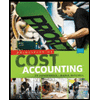1) Why do companies develop flexible budgets for variance analysis? Because actual activity level may not be the same as the budgeted activity level. Because flexible budgets reflect the normal production capacity. Because flexible budgets are more accurate than static budgets. Because static budgets become obsolete in the end of year when variance analysis are performed. 2) If excessive direct hours are used in the current operations, what variance would be resulted under the standard cost accounting? Unfavorable labor efficiency variance Favorable labor quality variance Favorable labor efficiency variance Unfavorable labor rate variance 3) The following actual and standard cost data for direct material and direct labor relate to the production of 4,000 units of product: Actual Costs Standard Costs Direct Material 4,900 lb. $5.85 per pound 5,000 lb. $5.90 per pound Direct Labor 1,900 hrs. $20.50 per hour 2,000 hrs. $20.00 per hour What is the materials price variance? $2,950 Unfavorable $245 Favorable $245 Unfavorable $2,950 Favorable
Master Budget
A master budget can be defined as an estimation of the revenue earned or expenses incurred over a specified period of time in the future and it is generally prepared on a periodic basis which can be either monthly, quarterly, half-yearly, or annually. It helps a business, an organization, or even an individual to manage the money effectively. A budget also helps in monitoring the performance of the people in the organization and helps in better decision-making.
Sales Budget and Selling
A budget is a financial plan designed by an undertaking for a definite period in future which acts as a major contributor towards enhancing the financial success of the business undertaking. The budget generally takes into account both current and future income and expenses.
1) Why do companies develop flexible
Because actual activity level may not be the same as the budgeted activity level.
Because flexible budgets reflect the normal production capacity.
Because flexible budgets are more accurate than static budgets.
Because static budgets become obsolete in the end of year when variance analysis are performed.
2) If excessive direct hours are used in the current operations, what variance would be resulted under the
Unfavorable labor efficiency variance
Favorable labor quality variance
Favorable labor efficiency variance
Unfavorable labor rate variance
3) The following actual and standard cost data for direct material and direct labor relate to the production of 4,000 units of product:
Actual Costs
Standard Costs
Direct Material
4,900 lb. $5.85 per pound
5,000 lb. $5.90 per pound
Direct Labor
1,900 hrs. $20.50 per hour
2,000 hrs. $20.00 per hour
What is the materials price variance?
$2,950 Unfavorable
$245 Favorable
$245 Unfavorable
$2,950 Favorable
Step by step
Solved in 2 steps







